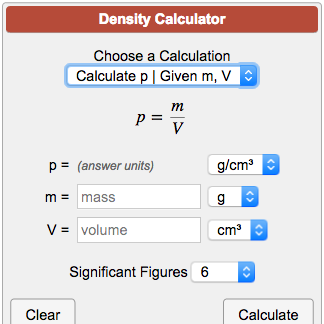
Wikipedia's Density page has a general discussion of density and its history, calculation, and units. However, the content of Wikipedia articles may change and so you may want to be cautious. Wikipedia's specific gravity page has an explanation of what specific gravity is and how it is used and even discusses its use in the geosciences and mineralogy. This includes several related pages including instructions of measuring density using the Archimedes principle. Hyperphysics, at the Georgia State has a page about density and a density converter. It allows you to look at pictures of measurements and to enter data. Or, if you want even more practice, see the links below More help with Density Edinformatics on-line lab on mass, volume and density is put together by NYU. If you think you have a handle on all of the things listed above click on this bar to try some practice problems with worked answers!

Have you wondered why hot air balloons rise? When the air is heated, it becomes less dense until the balloon's total density is less than that of the atmosphere A hot air balloon is literally floating on the denser, colder air.Here are some examples of how this explains everyday occurrences: Less dense substances will float on (or rise through) more dense substances. One of the most critical is that the density of a substance will determine if it will float on another. Why should I calculate density or specific gravity?ĭensities are critical for many uses. So we divide the basalt (210 lbs/ft 3) by the density of water (62.4 lbs/ft 3), and get S.G.= 3.37. The specific gravity is the density of the substance divided by the density of water, so Since specific gravity is unitless, it doesn't matter whether the density was measured in g/cm 3 or in some other units (like lbs/ft 3). It is very useful when comparing the density of two objects. However, specific gravity is a unitless number, and is the same in the metric system or any other measurement system. To calculate the specific gravity (SG) of an object, you compare the object's density to the density of water:īecause the density of water in g/cm 3 is 1.0, the SG of an object is will be almost the same as its density in g/cm 3. Rocks often have a density around 3 g/cm 3, and metals often have densities above 6 or 7 g/cm 3. Liquids often have densities of about 1.0 g/cm 3, and indeed, fresh water has a density of 1.0 g/cm 3. Typical densities for gasses are on the order of thousandths of grams per cubic centimeter.

This is because both the mass and the volume of the two minerals will be added, and so when they are divided to get the density the result will be between the two. If I have a rock that is made up of two minerals, one with a density of 2.8 g/cm 3, and one with a density of 3.5 g/cm 3, the rock will have a density between 3.5 and 2.8 g/cm 3, not a density of 6.3 g/cm 3. In this case the mass is 1000g and the volume is 400 cm 3, so you divide 1000g by 400 cm 3 to get 2.5 g/cm 3.Īnother tricky thing about density is that you can't add densities.

For density, you also need to consider the size, or volume, of the object.

A very large sponge may weigh a lot (have a high mass), but its density is low because it still weighs very little per unit of volume. The words heavy and light on their own refer to mass, and not density. Students, and even teachers, often confuse mass and density. If you pick up an iron skillet, you expect it to be heavy. You are not surprised when a large sponge is easy to lift. For example, sponges are low in density they have a low mass per unit volume. You probably have an intuitive feeling for density in the materials you use often. For example, gold will always have a density of 19.3 g/cm 3 if a mineral has a density other than that, it isn't gold. It is used quite often in identifying rocks and minerals since the density of substances rarely changes significantly. Density is a fundamental concept in the sciences you will see it throughout your studies.


 0 kommentar(er)
0 kommentar(er)
